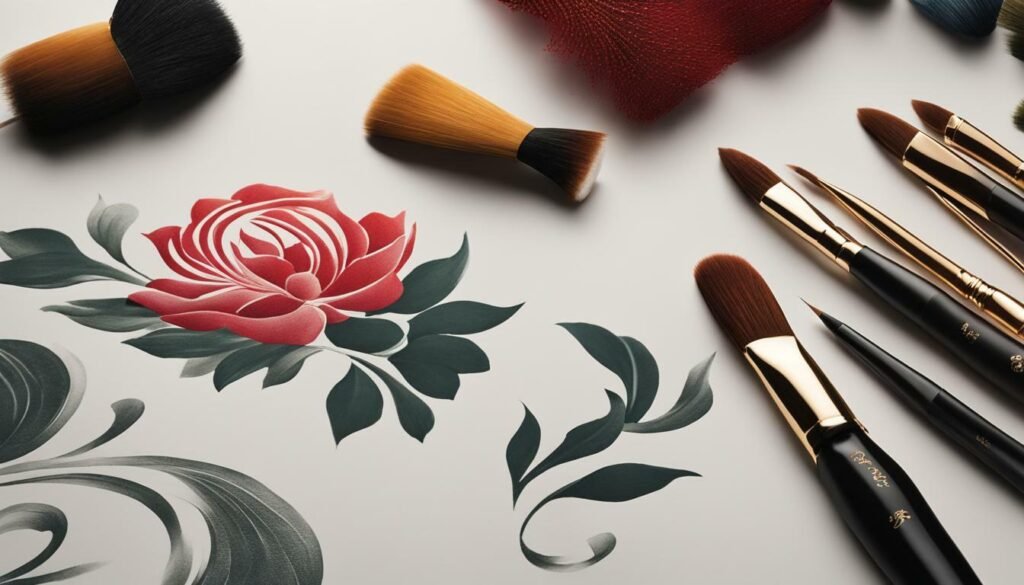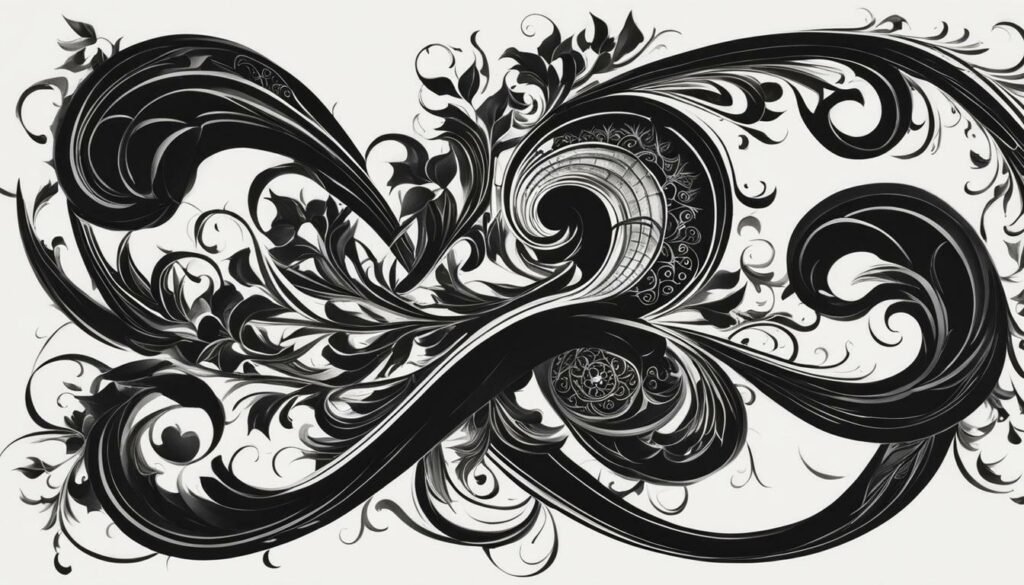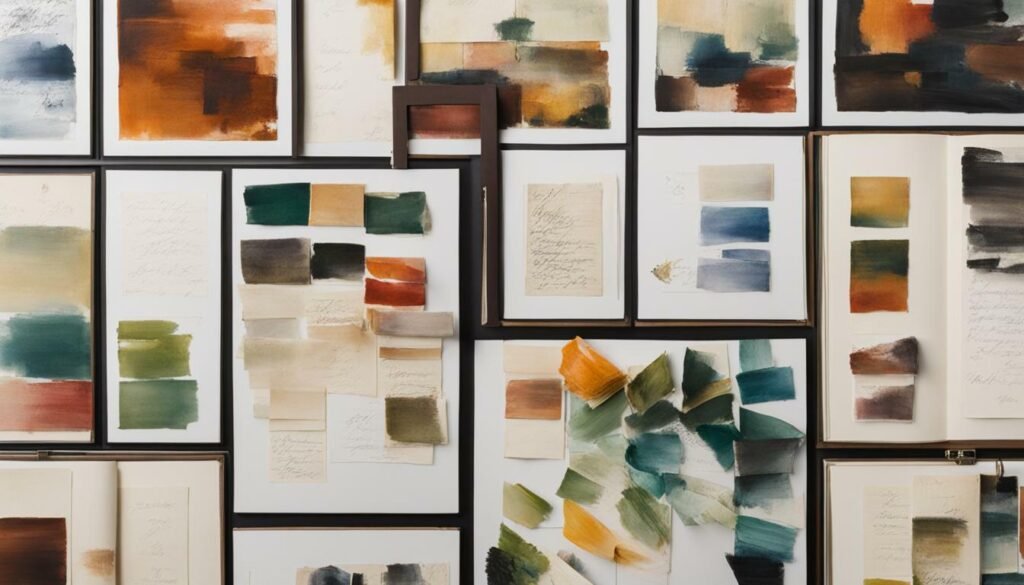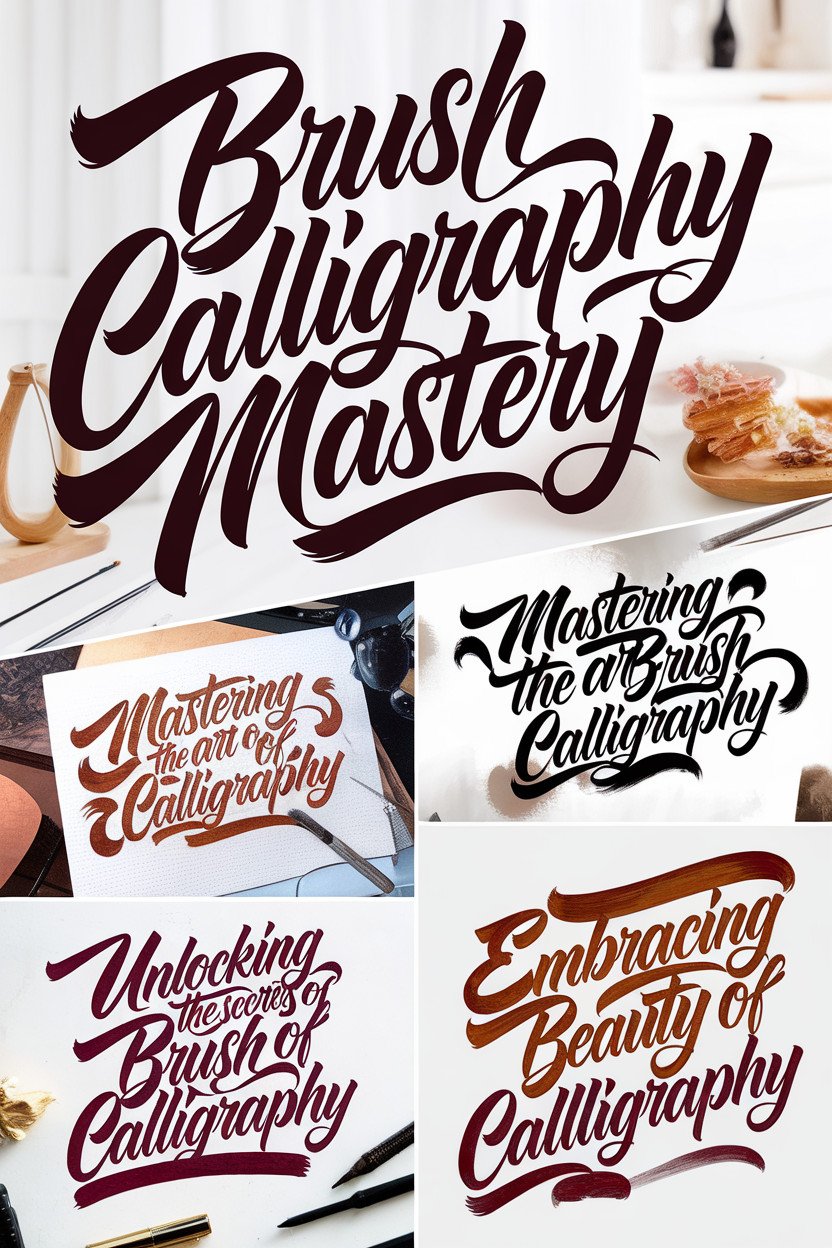In this comprehensive guide, you will discover the beautiful art of Calligraphy Brushwork and learn how to master it. From traditional calligraphy to modern brush lettering, we will provide you with the necessary techniques and tools to create stunning brush strokes and express your creativity.
Begin your journey to brilliance today and unlock the secrets behind Calligraphy Brushwork.
Key Takeaways:
- Learn the art of Calligraphy Brushwork, from traditional calligraphy to modern brush lettering.
- Discover the essential tools and materials needed for effective brush calligraphy.
- Master fundamental brushwork techniques, such as pressure control and spacing principles.
- Explore iconic traditional calligraphy styles, including Chinese Hanzi and Japanese Kanji.
- Incorporate calligraphy brushwork into graphic design projects and build a captivating portfolio.
Understanding Calligraphy Brushwork
Before you start practicing the techniques of calligraphy brushwork, it’s important to understand the origins and different styles of this art form. There are two main styles of calligraphy brushwork: Chinese brushwork and Japanese brushwork.
- Chinese brushwork is known for its expressive strokes, which are created by holding the brush upright and applying pressure to create thick and thin lines. This style is characterized by its use of complex characters and abstract imagery.
- Japanese brushwork, on the other hand, emphasizes simplicity and grace. The brush is held at an angle and the strokes are swift and precise, creating clean lines and smooth curves. This style is known for its minimalist designs and use of natural imagery.
Understanding the cultural significance and aesthetic principles behind each of these styles will provide a strong foundation for your own brushwork journey.

When it comes to Calligraphy Brushwork, having the right tools and materials is crucial. Here are some essential items you’ll need to get started:
- A calligraphy brush: Choose a brush that feels comfortable in your hand, with bristles that are soft and absorbent. Experiment with different sizes and shapes to find the one that works best for you.
- Ink: Look for high-quality ink that is suitable for calligraphy brushwork. Black ink is the most common, but you can also experiment with other colors.
- Paper: Use smooth and sturdy paper that won’t bleed or feather when you apply your brush strokes. Traditional calligraphy paper such as Xuan paper or Japanese washi paper can provide a unique texture.
Proper care and maintenance of your Calligraphy Brushwork supplies is important to ensure optimal results and longevity. Clean your brush after each use and store it properly to prevent the bristles from bending or losing their shape. Change your ink frequently to maintain its consistency and prevent it from drying out.

Calligraphy Brushwork requires mastering fundamental techniques to create beautiful brush strokes. Follow these steps to improve your brushstroke techniques:
- Hold the brush at a 45-degree angle for optimal control and pressure.
- Control pressure on the brush to create variance in the stroke width.
- Use different brushstrokes, including horizontal, vertical, diagonal, and curved.
- Practice consistent spacing between letters and words to promote readability.
- Focus on letterforms’ composition and rhythm to create a harmonious flow in your brushwork.

Practice these techniques regularly to improve your skills and create beautiful brushwork. With practice, you’ll be able to fine-tune the details of your brushstroke to produce unique and personalized artwork.
Traditional Calligraphy Styles
Traditional calligraphy styles have a rich history and are considered an integral part of many cultures. Here are some of the most iconic and widely used traditional calligraphic scripts:
- Chinese Hanzi
- Japanese Kanji
- Arabic script
- Indic scripts such as Devanagari and Brahmi
Each script has its own unique characteristics and aesthetic principles that make it stand out. For example, Chinese Hanzi is known for its elegant and graceful strokes, while Japanese Kanji has a more simplistic and minimalist approach.
Moreover, traditional calligraphy styles require precise and deliberate brushwork to create the right balance and harmony in the strokes. Understanding the techniques and nuances of these styles can help you develop a strong foundation for your brushwork journey.

Looking to add a modern twist to your calligraphy brushwork? Modern calligraphy and brush lettering offer endless possibilities for creativity and self-expression. Here are some tips to get you started:
- Experiment with different tools and mediums, such as watercolors, gouache, or metallic inks.
- Explore unconventional letterforms and typography styles, such as bold brushstrokes and playful flourishes.
- Incorporate personalized elements, such as your own handwriting or favorite quotes.
Remember, the beauty of modern calligraphy is in its versatility and adaptability. Play with different techniques and styles to find your own unique voice and create stunning brush lettering artworks that stand out from the crowd.

Calligraphy brushwork has been integrated into various art forms throughout history. Artists have utilized brushwork to convey movement, emotion, and texture in their creations. Here are some examples of how calligraphy brushwork has been used in different art forms:
- Traditional ink paintings: Calligraphy brushwork has been a vital component of traditional Chinese and Japanese ink paintings. Artists use brushwork to depict natural scenery, animals, and even people. The combination of brushwork and ink creates a unique visual style that is both simple and elegant.
- Contemporary mixed media artworks: Many modern artists incorporate calligraphy brushwork into their mixed media artworks. The use of brushwork adds an organic and personal touch to the pieces, creating a sense of intimacy and emotion.
- Typography: Calligraphy brushwork has become increasingly popular in typography and graphic design. Graphic designers use brush lettering to add a unique and personalized touch to logos, branding, and packaging designs.
Whatever your artistic inclination may be, integrating calligraphy brushwork into your creations is a powerful way to add depth and meaning to your artwork.

Congratulations on mastering the basic techniques of calligraphy brushwork! Now, let’s take your skills to the next level with advanced brushwork techniques.
- Experiment with creating gradients, textures, and shading with your brush to add depth and dimension to your artwork.
- Master the art of negative space to create a sense of balance and harmony in your compositions.
- Practice controlling ink flow to create smoother and more consistent brush strokes.
- Explore using different brushes and materials to achieve unique effects.
- Challenge yourself by experimenting with unconventional techniques and styles, pushing the boundaries of traditional calligraphy.
Remember, developing your brushwork proficiency is a continuous learning process. Take your time to practice and experiment with different techniques, and don’t be afraid to make mistakes. With dedication and patience, you’ll be amazed at what you can achieve with your calligraphy brushwork skills.

Calligraphy brushwork is not limited to traditional art forms, but it can also be applied in graphic design.
Incorporate the beauty of brush lettering in your logos, branding, and typography to add a touch of elegance and sophistication. You can also experiment with digitizing your calligraphy brushwork to create stunning digital artworks.

By adding calligraphy brushwork to your graphic design projects, you can create unique and eye-catching designs that stand out from the crowd.
Calligraphy Brushwork Workshops and Classes
Ready to take your brushwork skills to the next level? Consider attending a calligraphy brushwork workshop or class to deepen your knowledge and enhance your abilities:
- Join a local calligraphy society and attend their workshops and events to connect with like-minded individuals and learn from experienced instructors.
- Look for online calligraphy brushwork courses and tutorials, which offer step-by-step instructions and feedback from instructors.
- Consider attending a calligraphy brushwork retreat or intensive, which offer immersive learning experiences and the opportunity to network with fellow enthusiasts.
Remember, workshops and classes provide a supportive environment to practice and refine your brushwork skills, so don’t be afraid to ask questions and experiment with different techniques.

Building a Brushwork Portfolio
If you’re serious about calligraphy brushwork, building a portfolio is an excellent way to showcase your skills and attract potential clients. Here are some tips to get started:
- Choose your best pieces: Select 10-12 of your best brushwork pieces that showcase your unique style and range of techniques.
- Consider your presentation: Think about how you want to present your work. Do you prefer a physical portfolio or an online one? Make sure your presentation reflects your personal brand.
- Photograph your work: Take high-quality photographs of your pieces to include in your portfolio. Use natural light and a neutral background to ensure the focus is on your art.
- Add variety: Include a range of styles, techniques, and formats in your portfolio to demonstrate your versatility.
- Update regularly: Continue to add new pieces to your portfolio and refresh old ones to keep it up-to-date and reflective of your current skills.
With a well-curated and thoughtfully-presented portfolio, you can showcase your brushwork skills and attract potential clients or collaborators.

Are you interested in turning your passion for Calligraphy Brushwork into a fulfilling career? There are several ways to monetize your skills:
- Offer commissioned work: Create personalized artworks for clients, such as wedding invitations, logos, and signage. Advertise your services through social media, word-of-mouth, and online marketplaces.
- Teach workshops and classes: Share your expertise by offering in-person or online classes and workshops. Partner with local art schools, community centers, or online learning platforms.
- Sell your creations: Open an online store or sell your Calligraphy Brushwork creations at art fairs, markets, and galleries.
As you begin your Calligraphy Brushwork business, consider building your brand by:
- Creating a website or social media presence to showcase your portfolio and share your story.
- Networking with other artists, clients, and community members.
- Developing a unique style and aesthetic for your artwork.
Becoming a successful Calligraphy Brushwork entrepreneur takes dedication, hard work, and patience. But with the right mindset and business strategies, you can turn your passion into a profitable and fulfilling career.

Looking for a community of like-minded individuals who share your passion for calligraphy brushwork? There are many ways to connect with fellow enthusiasts and gain inspiration and support.
First, consider joining online forums or social media groups dedicated to calligraphy brushwork. Here, you can share your work, receive feedback, and engage in discussions with others who share your interests.
You can also seek out local meetup groups or workshops to connect with artists in your area. These can be great opportunities to learn new techniques, gain feedback on your work, and meet new friends.
Whether online or in-person, joining a calligraphy brushwork community can provide you with invaluable resources and support as you continue your artistic journey.

Now that you have read this comprehensive guide and gained valuable insights into the art of Calligraphy Brushwork, it’s time to put your newfound knowledge into practice. So, gather your brushes, ink, and paper, and start experimenting with different techniques and styles. Remember, the journey of mastering calligraphy brushwork is a continuous process that requires practice, dedication, and patience. Here are some tips to help you get started:
- Start with basic brushstroke techniques and practice them consistently.
- Experiment with different brush sizes and materials to discover your preferred tools.
- Explore traditional calligraphy styles and modern brush lettering to find your unique voice.
- Join a calligraphy brushwork community to connect with like-minded individuals and receive feedback on your work.
Embrace the journey of continuous learning and growth as you unleash your creativity and create your stroke of brilliance in Calligraphy Brushwork. Remember, there is no right or wrong way to approach this art form, so trust your instincts and have fun!
FAQ
What is Calligraphy Brushwork?
Calligraphy Brushwork refers to the art of creating beautiful and expressive letterforms and strokes using a brush. It is a traditional and elegant form of writing that has been practiced for centuries.
What are the different styles of Calligraphy Brushwork?
Calligraphy Brushwork encompasses various styles, including traditional calligraphy styles like Chinese Hanzi and Japanese Kanji, as well as modern calligraphy and brush lettering.
What tools and materials do I need for Calligraphy Brushwork?
To get started with Calligraphy Brushwork, you will need brushes of various sizes and materials, ink, and suitable paper. It’s important to select the right tools and materials for optimal results.
What are some basic techniques for Calligraphy Brushwork?
Basic techniques for Calligraphy Brushwork include learning how to hold the brush, control the pressure, and create different types of brush strokes. It’s also important to understand principles of spacing, composition, and rhythm.
Can I learn Calligraphy Brushwork online?
Yes, there are plenty of online resources, tutorials, and classes available that can help you learn Calligraphy Brushwork from the comfort of your own home.
Is Calligraphy Brushwork suitable for beginners?
Yes, Calligraphy Brushwork can be enjoyed by beginners as well as experienced artists. Starting with basic techniques and practicing regularly can help beginners develop their skills over time.
Can Calligraphy Brushwork be used in graphic design?
Absolutely! Calligraphy Brushwork can be applied in graphic design, particularly in areas such as logos, branding, and typography. It adds a unique and expressive touch to visual designs.
Are there workshops or classes available for Calligraphy Brushwork?
Yes, there are various workshops and classes dedicated to teaching Calligraphy Brushwork. These opportunities allow you to learn from experienced instructors and connect with fellow enthusiasts.
Can I turn my passion for Calligraphy Brushwork into a career?
Yes, there are business opportunities in the field of Calligraphy Brushwork, including freelance work, commissioned projects, and selling your creations. It’s important to develop your skills and market yourself effectively.
How can I connect with other enthusiasts of Calligraphy Brushwork?
You can connect with other enthusiasts of Calligraphy Brushwork through online forums, social media groups, and local meetups. These platforms create opportunities for sharing work, receiving feedback, and engaging in discussions.
Where can I find inspiration for my Calligraphy Brushwork?
You can find inspiration for Calligraphy Brushwork in various art forms, including traditional ink paintings and contemporary mixed media artworks. Exploring the work of renowned artists can spark ideas and help you develop your own artistic voice.
How do I build a portfolio for my Calligraphy Brushwork?
Building a captivating portfolio for your Calligraphy Brushwork involves carefully selecting and presenting your best work. It’s important to showcase your skill and style, and consider various formats, including photographs and digital representations.
Can I use Calligraphy Brushwork in combination with other art forms?
Yes, Calligraphy Brushwork can be integrated with other art forms, allowing you to explore new creative possibilities. You can combine brushwork with painting, drawing, collage, and more.
How can I improve my brushwork skills?
Improving your brushwork skills involves regular practice, seeking feedback, and continuously learning and experimenting with new techniques. Engaging in workshops, classes, and online tutorials can also help you refine your skills.
What are the best brushes for Calligraphy Brushwork?
The best brushes for Calligraphy Brushwork vary depending on personal preference and the specific style you wish to pursue. Brushes made from materials like goat hair or synthetic bristles are commonly used.
How can I achieve different effects with my brushwork?
Achieving different effects with your brushwork involves factors such as brush pressure, ink consistency, and brush angle. By experimenting with these elements, you can create variations in line thickness, texture, and shading.
Can I create digital artwork using Calligraphy Brushwork?
Yes, Calligraphy Brushwork can be digitized and used to create stunning digital artworks. There are various digital tools and software available that allow you to recreate the look and feel of traditional brushwork digitally.
